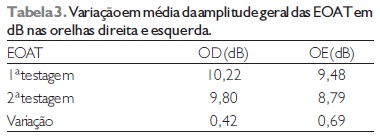INTRODUCTION: The noise is a harmful agent to the hearing, being frequent in urban and work environments. Among the structures of the hearing system, the outer hair cells are the first to be injured, and otoacoustic emissions identify minimal cochlear alterations. OBJECTIVE: Analyze cochlear alterations with otoacoustic emissions transient evoked in individuals exposed to combined risk: noise and chemical products. METHOD: 49 workers of a cement company participated of the research, aged between 19 and 49 years old, exposure time of at least two years and normal hearing thresholds. Was performed an anamnesis and otoacoustic emissions before and post work activity. The results of the exam were related with the variable: time of exposure to the noise, age, exposure to chemical products and sound habits. The statistical tests used were: T of Student, chi-squared Pearson test and Fisher's exact test and is characterized by a prospective clinical study. RESULTS: At the first testing, had presence of emissions in all of the workers. The average of amplitude is of 10,22 dBSPL in the right ear and 9,48 dBSPL in the left ear. In the second testing there were a variation of 0,69 dBSPL in the lef ear and 0,42 dBSPL in the right ear, of which 79,6% of individuals had presence of emission bilaterally and 20,4% absence in at least one ear. Analyzing the relation between variations of emissions with the variable was not observed statistically significant data. CONCLUSION: The otoacoustic emissions in the workers health search to prevent the damage to the hearing system through cochlear changings.
occupational noise; health worker services; hearing tests



